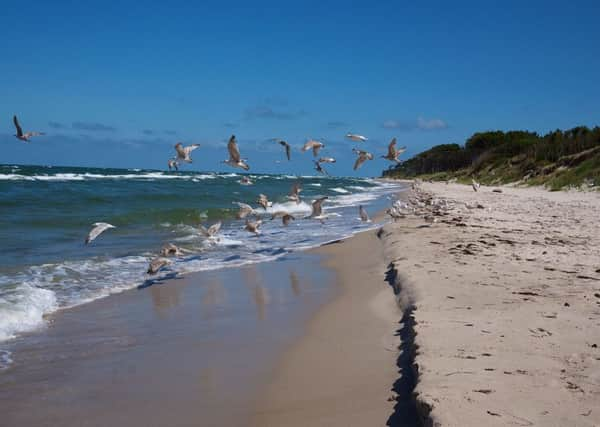Travel review: Baltic coast - The naked truth


The red robe was our secret code.
Bleary-eyed in the early morning sunshine, each day started with a tiptoe to the bathroom. If the robe was hanging on the door, I’d venture onto the beach.
An empty hook meant I’d creep back to bed. A trip to the Baltic coast with my German boyfriend and his parents necessitated a speedily-improvised bathing etiquette. As veterans of the ‘Freikoerperkultur’, or FKK, my in-laws championed “free body culture”.
Advertisement
Hide AdAdvertisement
Hide AdWhy bedraggle yourself with a bathing suit, when you can feel the waves crash on your body unencumbered? It was a good question, and one I embraced with enthusiasm – albeit in a limited way. When the red robe was hanging on the hook, I knew my in-laws were still in bed – so there was no danger of them seeing me in the all-together.
The FKK has its limits after all.
At 7am the beach was always deserted. Tiptoeing across the bone-white sand, with swallows dipping, diving, then disappearing into the .sky, I would shed the robe at the last minute and surrender myself to the Baltic sea.
The shock of the water was invigorating, and the clean air cleared my head. After a few minutes in the tap-clear water, I’d head back in for a family breakfast of warm rolls and Nudossi – an East German chocolate spread. For my in-laws, naked bathing was a cultural as well as a sensory issue. Now in their sixties, they’ve seen decades of turbulence in their East German home town – from the raising up of the Iron Curtain to the smashing down of the Berlin Wall. Under Communism, nudity was a statement of freedom. For that reason alone, it was a cherished part of their annual holiday at the Baltic sea.
Despite the 2,500 border guards, 70 watchtowers, barbed wire, and sweeping searchlights that flanked the Baltic coast from Lubeck to Usedom until only 20 years ago, no one told them to put their clothes back on. “At home, you’d never know who was listening and reporting back on your conversations,” confides my boyfriend’s mum as she pours our morning coffee.
Advertisement
Hide AdAdvertisement
Hide Ad“Naked, we could speak more freely. Party members wouldn’t come to FKK beaches – there was nowhere to hide the recording equipment.”
Twenty years on, the FKK movement no longer has the same political resonance – but the sensation of freedom remains skin-tinglingly vivid.
Thanks to communism, the coast escaped Sixties development blight. Dotted with “niedliche” (cute) thatched cottages, Zingst is set in a national park; driftwood-strewn sand white as sugar, framed by gnarly trees and miles of uninterrupted sea views.
In one wind-battered stretch, walkers had used driftwood to build a makeshift shelter, studded with wind-powered totems and interlaced with found objects from feathers to washed-up glass medicine bottles.
Advertisement
Hide AdAdvertisement
Hide AdBeachcombers often spend hours picking through the seaweed hoping to spot treasures – those who look for long enough may even be rewarded with a big chunk of amber.
There’s wildness here on the edge of Europe, and it feels exciting to be so far away from the familiar sights of Spanish or French beaches. Here on the Baltic coast I didn’t hear another English speaker. Everything, from the menus to the tourist signs, is in German.
Back on the coast, where curiously there is no tide, the beaches are quiet and mainly frequented by families (not all of whom are always nude).
Some areas encourage the wearing of swimwear, while in others it’s forbidden.
Advertisement
Hide AdAdvertisement
Hide AdEither way, there are plenty of blue-and-white-striped “Strandkorb” (or sea chairs) to relax in.
As I sit in one of these traditional wicker seats watching the sun go down one evening, it’s hard to imagine that 189 people died trying to escape to the West from here.
Incredibly, some succeeded. As recently as 1987, one desperado swam the 28-mile crossing to Denmark on a lilo. It seems fitting to celebrate their efforts with my own small gesture of defiance; escaping for my morning swim in the red robe, facing the day wearing nothing but my birthday suit.
FACTFILE
• Airbnb is a good place to look for a holiday home on the Fischland-Darss peninsula, the narrow spit of land between the Bodden and the sea.
Advertisement
Hide AdAdvertisement
Hide AdZingst is a great place for families, while Prerow is arty, with some lovely restaurants. Among the holiday cottages there are also houseboats for rent, including a 13m boat moored near Zingst from £122 per night. Seewww.airbnb.co.uk
Flights to Berlin leave from Manchester airport frequently, with KLM amongst the airlines offering regular flights. From there, it’s best to hire a car to get to the Baltic coast. The sea can be reached by car from Berlin in 3-4 hours.
Alternatively, consider flying to Copenhagen for a long weekend before your seaside stay. A train ride through Denmark and a ferry ride to Rostock will take you straight to the heart of the coast.